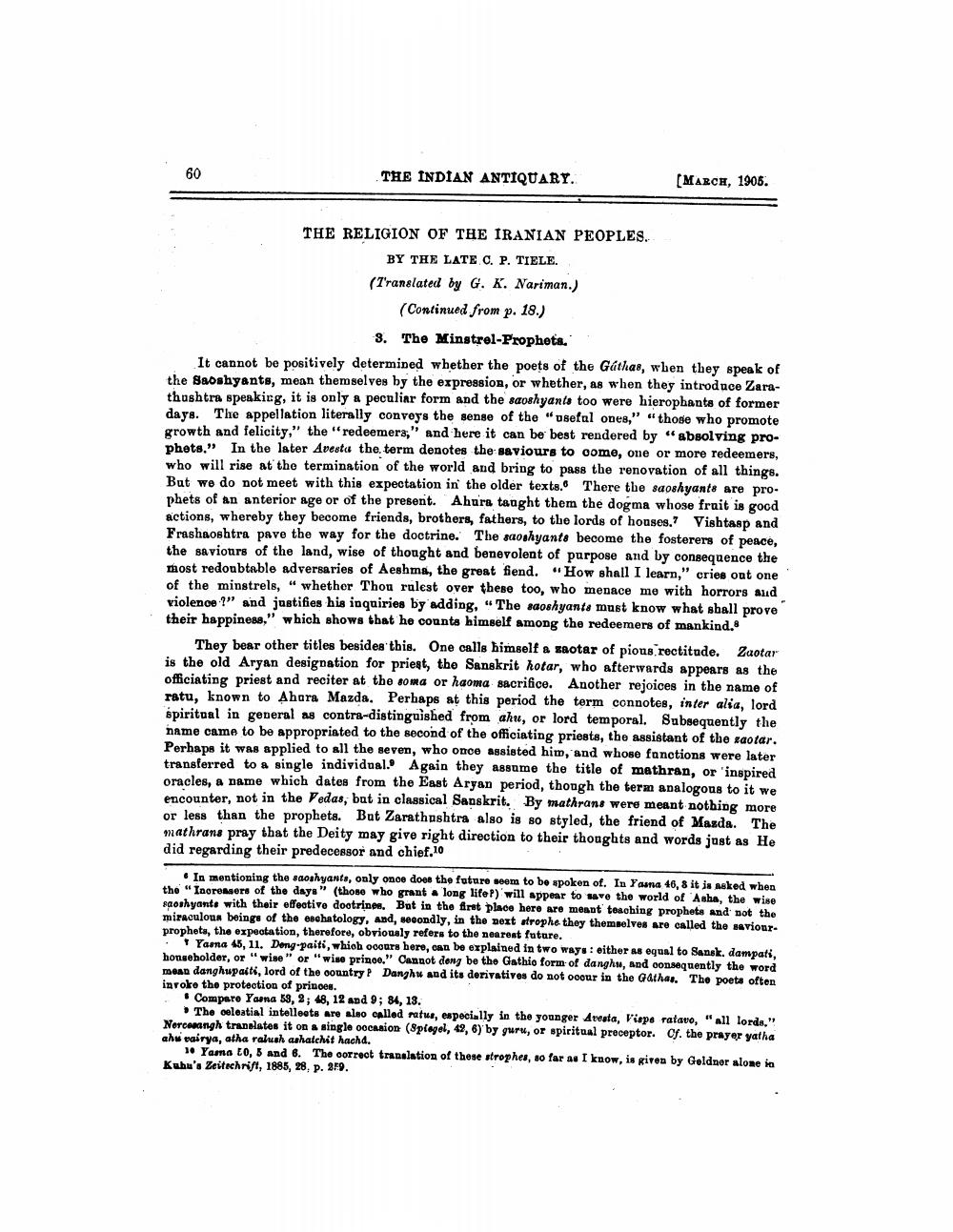________________
THE INDIAN ANTIQUARY.
[MARCH, 1905.
THE RELIGION OF THE IRANIAN PEOPLES.
BY THE LATE C. P. TIELE. (Translated by G. K. Nariman.)
(Continued from p. 18.)
3. The Minstrel-Propheta. It cannot be positively determined whether the poets of the Gáthas, when they speak of the Saoshyants, mean themselves by the expression, or whether, as when they introduce Zarathoshtra speakirg, it is only a peculiar form and the saoshyants too were hierophants of former days. The appellation literally conveys the sense of the "Usefal ones," "those who promote growth and felicity," the "redeemera," and here it can be best rendered by “absolving prophets.” In the later Avestu the term denotes the saviours to come, one or more redeemers, who will rise at the termination of the world and bring to pass the renovation of all things. But we do not meet with this expectation in the older texts. There the saoshyants are prophets of an anterior age or of the present. Ahura taught them the dogma whose fruit is good actions, whereby they become friends, brothers, fathers, to the lords of houses.? Vishtasp and Prashaoshtra pave the way for the doctrine. The saoshyants become the fosterers of peace, the saviours of the land, wise of thought and benevolent of purpose and by consequence the most redoubtable adversaries of Aeshma, the great fiend. "How shall I learn," cries ont one of the minstrels,whether Thou ralest over these too, who menace me with horrors and violence ?" and justifies his inquiries by adding, "The saoshyants must know what shall prove their happiness," which shows that he counts himself among the redeemers of mankind.
They bear other titles besides this. One calls himself & xaotar of pions rectitude. Zaotar is the old Aryan designation for priest, the Sanskrit hotar, who afterwards appears as the officiating priest and reciter at the soma or haoma sacrifice. Another rejoices in the name of ratu, known to Ahora Mazda. Perhaps at this period the term connotes, inter alia, lord spiritual in general as contra-distinguished from aku, or lord temporal. Subsequently the name came to be appropriated to the second of the officiating priests, the assistant of the xaotar. Perhaps it was applied to all the seven, who once assisted him, and whose fanctions were later transferred to a single individual. Again they assume the title of mathran, or inspired oracles, a name which dates from the East Aryan period, though the term analogous to it we encounter, not in the Vedas, but in classical Sanskrit. By mathrans were meant nothing more or less than the prophets. But Zarathashtra also is so styled, the friend of Mazda. The mathrans pray that the Deity may give right direction to their thoughts and words just as He did regarding their predecessor and chief.10
• In mentioning the saoshyants, only once does the future seem to be apoken of. In Yasna 46, 8 it is asked when the "Inorenners of the days" (those who grant a long life?) will appear to save the world of Asha, the wise saoshyants with their effective doctrines. But in the first place here are meant teaching prophets and not the miraculous beings of the eschatology, and, secondly, in the next strophe they themselves are called the saviour. prophets, the expectation, therefore, obviously refers to the nearest future. • " Yama 45, 11. Dong-paiti, which occurs here, can be explained in two ways: either as equal to Sansk, dampati, honseholder, or "wise" or "wise prince." Cannot dong be the Gathio form of danghu, and consequently the word mean danghupatti, lord of the country Danghu and its derivatives do not ooour in the Gathas. The poets often inroke the protection of princes
Compare Yarna 59, 2; 48, 12 and 9; 84, 13.
The celestial intellects are also called ratus, especially in the younger Aresta, Vispa ratave, "all lords." Nercemangh translates it on a single occasion (Spiegel, 42, 6) by guru, or spiritual preceptor. Cf. the prayer yatha ahu vairya, atha ralush ashatchit hachd.
• Yamo to, 5 and 6. The correct translation of these strophes, so far as I know, is given by Goldner alone in Kubu's Zeitschrift, 1885, 28, p. 29.




